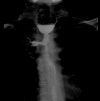Risk Factors Associated with Esophageal Fistula after Radiotherapy for Esophageal Squamous Cell Carcinoma
- PMID: 32284766
- PMCID: PMC7150448
- DOI: 10.7150/jca.39033
Risk Factors Associated with Esophageal Fistula after Radiotherapy for Esophageal Squamous Cell Carcinoma
Abstract
Purpose: The aim of this study was to investigate risk factors for esophageal squamous cell carcinoma (ESCC) treated with radiotherapy (RT) with or without chemotherapy to guide how to reduce the occurrence of esophageal fistula (EF). Methods: 414 patients with ESCC who underwent RT with or without chemotherapy were collected in Shandong Cancer Hospital from February 2012 to June 2018 retrospectively. The clinical characters and dosimetric parameters were recorded. Univariate and multivariate logistic regression analyses were provided to determine the risk factors associated with EF. Results: The cumulative incidences of EF were 11.1% (46/414 patients). The median follow-up period was 15.8 months (range: 0.2-82.6months). The median survival time (MST) of patients with EF was 5.3 months. In univariate analysis, age, T4 stage, N3 stage, chemotherapy regimens, re-RT, ulcerative esophageal cancer (EC), esophageal stenosis, the maximum thickness of the tumor and the length of tumor had a correlation with the prevalence of EF. In multivariable logistic regression analysis, T4 stage, N3 stage, re-RT, ulcerative EC, esophageal stenosis, the maximum thickness of the tumor was confirmed as risk factors for EF. Conclusion: This study revealed that T4 stage, N3 stage, re-RT, ulcerative EC, esophageal stenosis, the maximum thickness of the tumor were risk factors associated with EF. We ought to attach importance to the prevention of EF. Patients with risk factors for EF should be paid close attention.
Keywords: esophageal fistula; esophageal squamous cell carcinoma; radiotherapy; risk factor; side effect.
© The author(s).
Conflict of interest statement
Competing Interests: The authors have declared that no competing interest exists.
Figures




Similar articles
-
Risk factors of esophageal fistula induced by re-radiotherapy for recurrent esophageal cancer with local primary site.BMC Cancer. 2022 Feb 24;22(1):207. doi: 10.1186/s12885-022-09319-4. BMC Cancer. 2022. PMID: 35209855 Free PMC article.
-
Clinical-radiomics nomogram for the risk prediction of esophageal fistula in patients with esophageal squamous cell carcinoma treated with intensity-modulated radiation therapy or volumetric-modulated arc therapy.J Thorac Dis. 2024 Mar 29;16(3):2032-2048. doi: 10.21037/jtd-24-191. Epub 2024 Mar 20. J Thorac Dis. 2024. PMID: 38617757 Free PMC article.
-
Risk factors and prognosis for esophageal fistula in patients with esophageal squamous cell carcinoma during radiotherapy.Esophagus. 2022 Oct;19(4):660-669. doi: 10.1007/s10388-022-00919-4. Epub 2022 Apr 13. Esophagus. 2022. PMID: 35419642
-
Incorporation of PET Metabolic Parameters With Clinical Features Into a Predictive Model for Radiotherapy-Related Esophageal Fistula in Esophageal Squamous Cell Carcinoma.Front Oncol. 2022 Feb 28;12:812707. doi: 10.3389/fonc.2022.812707. eCollection 2022. Front Oncol. 2022. PMID: 35296024 Free PMC article.
-
Risk Factors for Esophageal Fistula in Esophageal Cancer Patients Treated with Radiotherapy: A Systematic Review and Meta-Analysis.Oncol Res Treat. 2020;43(1-2):34-41. doi: 10.1159/000503754. Epub 2019 Oct 22. Oncol Res Treat. 2020. PMID: 31639800
Cited by
-
Prognostic factors for esophageal respiratory fistula in unresectable esophageal squamous cell carcinoma treated with radiotherapy.Sci Rep. 2024 Jul 26;14(1):17144. doi: 10.1038/s41598-024-67859-0. Sci Rep. 2024. PMID: 39060397 Free PMC article.
-
Palliative management of a malignant tracheoesophageal fistula using repeat endobronchial laser debridement and esophageal stenting.J Surg Case Rep. 2023 Dec 30;2023(12):rjad590. doi: 10.1093/jscr/rjad590. eCollection 2023 Dec. J Surg Case Rep. 2023. PMID: 38164211 Free PMC article.
-
Quantitative CT analysis to predict esophageal fistula in patients with advanced esophageal cancer treated by chemotherapy or chemoradiotherapy.Cancer Imaging. 2022 Nov 4;22(1):62. doi: 10.1186/s40644-022-00490-2. Cancer Imaging. 2022. PMID: 36333763 Free PMC article.
-
Risk factors of esophageal fistula induced by re-radiotherapy for recurrent esophageal cancer with local primary site.BMC Cancer. 2022 Feb 24;22(1):207. doi: 10.1186/s12885-022-09319-4. BMC Cancer. 2022. PMID: 35209855 Free PMC article.
-
Prediction of malignant esophageal fistula in esophageal cancer using a radiomics-clinical nomogram.Eur J Med Res. 2024 Apr 4;29(1):217. doi: 10.1186/s40001-024-01746-2. Eur J Med Res. 2024. PMID: 38570887 Free PMC article.
References
-
- Chen W, Zheng R, Baade PD, Zhang S, Zeng H, Bray F. et al. Cancer statistics in China, 2015. Ca Cancer J Clin. 2016;66:115–32. - PubMed
-
- Pasquier D, Mirabel X, Adenis A, Rezvoy N, Hecquet G, Fournier C. et al. External beam radiation therapy followed by high-dose-rate brachytherapy for inoperable superficial esophageal carcinoma. Int J Radiation Oncology Biol Phys. 2006;65:1456–61. - PubMed
-
- Kato H, Nakajima M. Treatments for esophageal cancer: a review. Gen Thorac Cardiovasc Surg. 2013;61:330–5. - PubMed
-
- Cooper JS, Guo MD, Herskovic A, Macdonald JS, Martenson JA Jr, Al-Sarraf M. et al. Chemoradiotherapy of Locally Advanced Esophageal Cancer: Long-term Follow-up of a Prospective Randomized Trial (RTOG 85-01) J Am Med Assoc. 1999;281:1623–7. - PubMed
LinkOut - more resources
Full Text Sources

